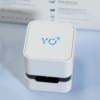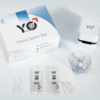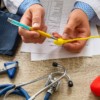Is it time?
Two months into the Covid-19 pandemic, and the world of reproductive medicine, like so many other fields, is in a state of limbo. The significant regional differences in the spread of the disease have led to the loosening of shelter-in-place restrictions in some areas, while others remain under tight lockdown. Although some couples may now be able to continue on their fertility journey, many practitioners and patients are also left with enormous uncertainty about what is safe and what isn’t.
The American Society for Reproductive Medicine (ASRM), a global leader in reproductive medicine, has updated its guidelines to reflect the changing landscape. In March, the ASRM recommended a moratorium on all new treatment cycles and all non-urgent activity. Recognizing the time-sensitive nature of many fertility treatments, and the improved conditions in some areas, the new recommendations for April 24-May 11, 2020 allow diagnostics and treatment to resume in some cases and provide practical details to help both clinicians and patients understand when and how it is safe to resume them.
Is it safe to resume in-clinic care?
The new ASRM guidelines emphasize, first and foremost, the centrality of local conditions and state regulations in deciding when and how to reopen or continue activity in an individual practice. They recommend on-site treatment only when there has been a sustained reduction in Covid-19 cases in the area for at least 14 days and local hospitals have the ability to safely treat all patients without resorting to crisis standards of care.
If local conditions meet those standards, they recommend that practices and clinics perform a formal risk assessment of both their clinical activities and the physical location. Using the guidelines issued by the CDC and state government, clinics should create detailed risk mitigation policies or adapt existing ones to meet the unique challenges of a pandemic. All staff members should undergo rigorous training in the new policies and procedures before patients are allowed on-site, and strict protective measures for both patients and staff should be adopted, including but not limited to:
- Screening all patients and staff at the clinic with temperature checks and background questioning
- Sanitizing equipment and surfaces frequently
- Enforcing social distancing
- Requiring all patients and staff to wear face masks and wash hands regularly
Before you go to your clinic, make sure that these steps have been taken. Ask about your clinic’s risk mitigation policies, staff training and protective measures. Don’t be shy, asking questions is legitimate. After all, your health is on the line.
Should you go?
The decision of whether or not you should go to a clinic for fertility diagnostics and treatment really depends on your individual circumstances. In areas where there has been a virus cluster, it may be a good idea to wait, especially with treatment that isn’t time sensitive. Likewise, if you, or any of your close family members are in a high-risk category for Covid-19 (for example, the elderly, or people suffering from pre-existing conditions like hypertension or diabetes), you may also want to delay your return to a clinical setting.
No matter what you decide, home sperm testing is always a safe alternative. By testing your sperm at home, you can supply your reproductive medicine provider with valuable diagnostic information with no risk of exposure to Covid-19. You can also use the quiet of social distancing to start taking steps to improve your sperm count and motility by improving diet, exercise and sleep habits. Likewise, there has been concern that Covid-19 could negatively impact male fertility, although it hasn’t been proven. If you think you may have contracted Covid-19, testing your sperm at home will let you know whether your count or motility has been impacted.
If you are interested in taking a test, use code – ATHOME20 – to receive 20% off your YO Order through May 11th, 2020.
Stay Healthy and Well!
– YO Team







